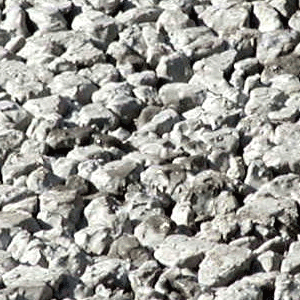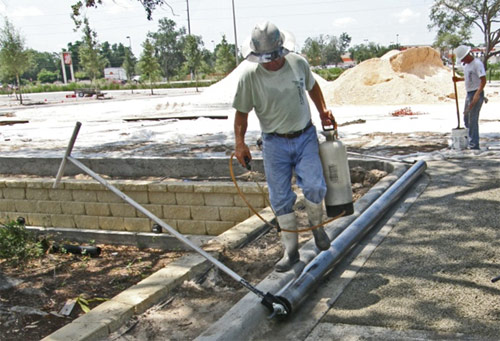Important Factors
Base preparation includes testing existing undisturbed sub-soil for its ability to percolate. If the water table is at least 4 ft. below grade and septic fields work in the area, probably the permeability of the sub soil will be adequate. The base soil should be appraised by a site engineer. In a few cases this will involve taking test borings. Again we stress all organic materials such as roots, grass and trash must be thoroughly removed. Then a compactable, porous sub-base should be installed, and compacted with a vibratory compactor to a level of proctor level of approximately 92%. where sandy, compactable sub-soils are fould they may be converted into a base for pervious concrete. A properly compacted base will not be damaged by ready-mix trucks delivering the pervious concrete.
If the soil is slow draining a base of crushed concrete, or other stable aggregate should be installed and compacted to a level of 95%. This is usually 6″ thick or more.
The installed base.

Crushed Stone. Pervious Concrete BaseWhile the engineered mixture is important there are other factors to consider such as: having a suitable base of soil, sand or crushed stone; having a drainable water table, sufficiently below the pavement is also important. Other factors are the proper preparation of an appropriate compacted, sub-base free of all organic matter, the correct concrete mixture, the designed mixing procedure, prompt placement, finishing and proper curing. Curing, really means hydration, a chemical process that requires the presence of moisture. To prevent evaporation, Pervious Concrete should be covered with polyethylene film for a week or more. The sub-base can consist of sand, crushed stone or a combination of drainable materials. If crushed stone is used the base can serve as a detention pond.
Pervious concrete is usually delivered to the site in Ready Mix trucks and mixed at a specified mixing speed to result in 75 to 100 rotations of the mixing drum before discharge. After the closely controlled amount of water is added, one hour is usually the maximum time allowed for discharge. The batch must be placed, rolled, sprayed and covered quickly. This closely monitored process produces a pavement with unique characteristics. This allows it to recharge the aquifer beneath, to prevent puddles and to reduce drainage into storm sewers, streams and adjacent properties.

Some of our competitors claim Pervious Concrete will allow 8 to 12 gallons per square foot per minute to pass through it. This will depend on the sub-base and size and type of aggregate. Our tests with a 3/8″ aggregate indicate that it will allow 3 to 10 gallons of water to pass through it per minute, compared to 2.5 to 4 gallons for Bahia grass. Larger aggregate in an appropriate mix design will drain better. In any event,1½” of rainfall, a good first flush, will represent .6234 gallons, almost five times the average three gallon minimum, if it fell within 60 seconds, an unusually heavy rainfall. How well it performs is almost always determined by what lies below it. Total percolation is mostly dependent upon base construction, aggregate size and existing soil and water table conditions.
